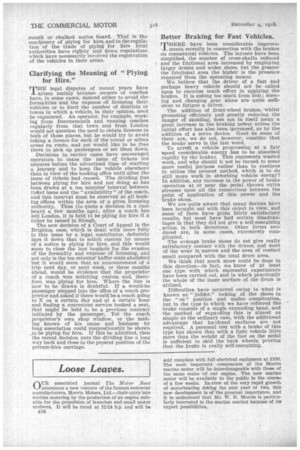Better Braking for Fast Vehicles.
Page 2

If you've noticed an error in this article please click here to report it so we can fix it.
THERE have been considerable improve • meats recently in connection with the brakes on commercial vehicles. The layouts have been simplified, the number of cross-shafts reduced and the frictional area increased by employing larger drums and wider shoes, but the greater the frictional area the higher is the pressure required from the operating means. We believe that the driver of a fast and perhaps heavy vehicle should not be called upon to exercise much effort in applying the brakes. It is asking too much from him; steering and changing gear alone are quite sufficient to fatigue a driver. The addition of front-wheel brakes, whilst promoting efficiency and greatly reducing the danger of skidding, does not in itself mean a great increase in the braking power unless the initial effort has also been increased, as by the addition of a servo device. Good as some of them are, we do not, however, consider that the brake servo is the last word. To arrest a vehicle progressing at a fair speed considerable energy has to be absorbed rapidly by the brake3. This represents wasted work, and why should it not be turned to some more useful purpose rather than to continue to utilize the present method, which is to do still more work in absorbing vehicle energy? In addition, any increase in the power of brake operation at or near the pedal throws extra stresses upon all the connections between the point of application of this power and the brake shoes. We are quite aware that many devices have been brought out with this object in view, and some of them have given fairly satisfactory results, but most have had certain disadvantages in that they did not give a self-energizing action in both directions. Other forms produced are, in some cases, excessively complicated. The average brake shoes do not give really satisfactory contact with the drums, and most of the wear is uneven and the area of contact small compared with the total drum area. We think that much more could be done in this direction—in fact, we know of at least one type with which successful experiments have been carried out, and in which practically the whole of the inner surface of the drum is utilized. Difficulties have occurred owing to what is known as "judder," locking of the shoes in the " on " position and undue complication, but in the type to which we have referred the brake consists of a single expanding band, and the method of expanding this is almost as simple as the ordinary cam, with the additional advantage that hardened surfaces are not required. A personal test with a brake of this type has shown that with a light vehicle little more than the weight of the foot on the pedal is sufficient to skid the back wheels, proving that the brake is really self-energizing.






























